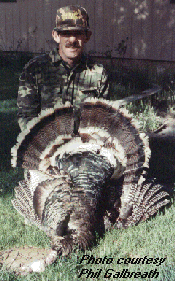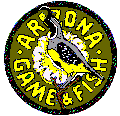|
 A wary and keenly observant bird, the wild turkey
makes for an extremely challenging hunt. The display of the male
(tom) includes an impressive fanning of its large tail feathers. A wary and keenly observant bird, the wild turkey
makes for an extremely challenging hunt. The display of the male
(tom) includes an impressive fanning of its large tail feathers.
Description: Bronze, iridescent body with paler,
barred wings. Tail feathers are buff-bronze with whitish tips. Head
has no feathers and is a mottled blue with red wattles.
Habitat: Mountain forests and broken woodlands. Also found in
logged-over land and oak stands. Roosts in tall, older pine trees.
Leaves roost site at daybreak to feed. Spends warmer part of day
"loafing" in or near brush piles or downed trees where cover is
readily available. Turkey are usually found in elevations between
5000 and 9000 feet, along the Mogollon Rim and White Mountains.
Food Preferences: Insects, juniper berries, acorns,
grass seed, mast, pine seeds, and green weeds.
Breeding
notes: Breeds April through May. Young hatch in June, with an
average clutch of nine chicks.
Predators or Enemies: Bobcats, coyotes, foxes,
eagles, and horned owl.
Size Individual Range:
5-30 square miles
Distribution: 5,000-9,000 feet along the Mogollon Plateau
and White Mountains.
Live Weight: Male: 15-30 lbs.
/ Female 8-12 lbs.
Hunting hints: Complete
camouflage clothing is essential. Weapons and bare skin (face,
hands, etc.) should be camouflaged as well. A U.S. Forest Service Apache-Sitgreaves National Forests map is
essential. Plan on scouting for evidence and appearance of turkey
prior to your hunt. Set up hunting spot prior to daylight near
roosting area. A good call, or the ability to call turkey, is a
necessary spring hunting tool.
 Information courtesy Arizona Game & Fish
Department, Region 1-Pinetop,AZ Information courtesy Arizona Game & Fish
Department, Region 1-Pinetop,AZ
|

